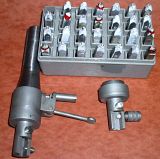Hi all,
I'm new to the site and entranced by the knowledge here. I'm a long term machinist - welder that is new to modelling. I have this project I've been working on that I wish to make a small name-board (aka label) out of brass plate for.
There has to be a slick way to line up hand stamp letters and numbers (app. 1/4" in height) and make a nice looking label .... I just haven't figured it out. In my tugboat engineer days I saw many examples of very nice hand lettering on valve labels so I know it can be done.
Does anybody here know the secret?
Thanks
Jim Slocomb
Friday Harbor, WA
I'm new to the site and entranced by the knowledge here. I'm a long term machinist - welder that is new to modelling. I have this project I've been working on that I wish to make a small name-board (aka label) out of brass plate for.
There has to be a slick way to line up hand stamp letters and numbers (app. 1/4" in height) and make a nice looking label .... I just haven't figured it out. In my tugboat engineer days I saw many examples of very nice hand lettering on valve labels so I know it can be done.
Does anybody here know the secret?
Thanks
Jim Slocomb
Friday Harbor, WA





